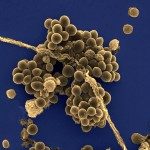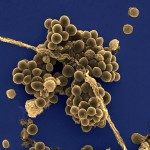Link to Pubmed [PMID] – 15808931
Res. Microbiol. 2005 Apr;156(3):289-97
Bacterial surface proteins constitute a diverse group of molecules with important functions, such as adherence, invasion, signaling and interaction with the host immune system or the environment. In Gram-positive bacteria, many surface proteins are anchored to the cell wall envelope by an enzyme named sortase, which recognizes a conserved carboxylic sorting motif. The sequence of the prototype staphylococcal SrtA has been widely used to identify homologs in bacterial genomes, revealing a profusion of sortases in almost all Gram-positive bacteria, often with more than one sortase-like protein per genome [M.J. Pallen, A.C. Lam, M. Antonio, K. Dunbar, Trends Microbiol. 9 (2001) 97-102]. In light of increasing reports on the identification and/or characterization of paralogous sortase genes, a classification of sortases now appears necessary. This report provides an analysis of sixty-one sortases from complete Gram-positive genomes, and suggests the existence of four structural groups of sortases. We propose the classification of sortases into 4 classes designated A, B, C and D. This classification should help to discriminate between sortases in the future.

